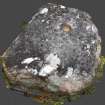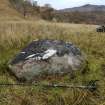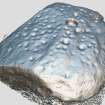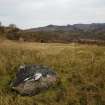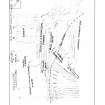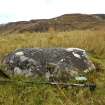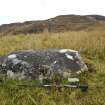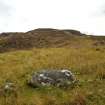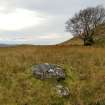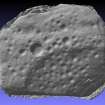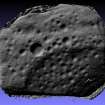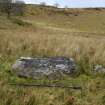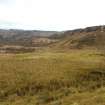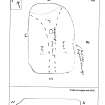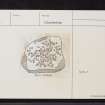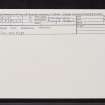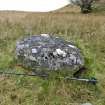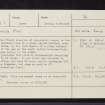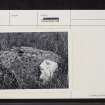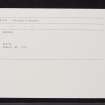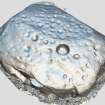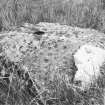Torr Mor, Ghaodeil, Arisaig
Cup Marked Stone (Neolithic) - (Bronze Age)
Site Name Torr Mor, Ghaodeil, Arisaig
Classification Cup Marked Stone (Neolithic) - (Bronze Age)
Canmore ID 22528
Site Number NM68SE 1
NGR NM 66859 84451
Datum OSGB36 - NGR
Permalink http://canmore.org.uk/site/22528
- Council Highland
- Parish Arisaig And Moidart
- Former Region Highland
- Former District Lochaber
- Former County Inverness-shire
NM68SE 1 6686 8446.
One of the finest examples of cup-marked stones in the west of Scotland lies at a place called Gaoidal, near Arisaig House, on the bare summit of a ridge between the arm of the sea on the south called Loch-nan-Uagh, and an open valley to the north.
It is a prostrate flat slab of micha-schist measuring 5 x 4 x 1 1/2ft thick. It was found and sketched in 1881 by Jolly, and bore 82 cups, mostly averaging 2-3 inches in diameter, but some as much as 6".
W Jolly 1882.
NM 6686 8446. This cup-marked stone is as described by Jolly.
Surveyed at 1/10,000
Visited by OS (NKB) 19 May 1970
As above: noted during desk-based assessment and field investigation prior to woodland regeneration programme.
Information from CFA Report, 1994 (No. 161) MS/726/176
Note (14 November 2019)
Date Fieldwork Started: 14/11/2019
Compiled by: NOSAS
Location Notes: The panel is located about 3 miles South of Arisaig in a deserted multi-period settlement called Ghaoideil from which the stone takes its name (pronounced 'Goochel'). It lies near the top of a broad N-S pass surrounded by ridge and furrow cultivation remains, and about 30m W of the footpath to the settlement and the shore. Bare heather covered slopes rise to the E whilst to the W the rising slopes are a mix of heather bracken and woodland. The stone lies on the edge of an area of rig and furrow now marshy with Juncus rush and sphagnum dominant as a result of neglected drainage. It can only be seen from the slopes to the W and is easy to miss due to the undulating ground near the top of the pass. From the panel there are extensive views NE, but in order to look S to Moidart and the sea one must walk 100m to the top of the pas
Panel Notes: This is a roughly rectangular schist boulder measuring 1.5 x 1.3m, with a maximum height of 0.4m. It lies flat and level on the ground. All of the surface is decorated. The top of the stone is slightly hog backed and hipped to the N giving the effect of three faces, though the hog itself is decorated and includes the largest cup. There are up to 85 circular and sub-circular depressions on the upper surface, with sizes varying from 14cm diameter and 7.5cm deep to 2.5cm diameter and 0.2-0.3cm deep. Some are oval or slightly irregular in shape and are likley to be natural features, as is the largest depression, which is straight sided and may have been enhanced with a metal tool. Closer inspection is needed to determine whether some of the features are cupmarks of prehistoric date. The rock surface is eroded and there is physical damage on the E side due to being struck by a sledgehammer or heavy machine. The cups are usually full of water and sheep dung but not on the day of recording. The visiting public frequently leave 'offerings' of coins or pebbles in the larger cups.






























